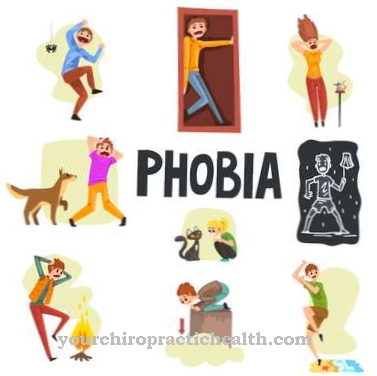As Snakebite is an injury with possible poisoning that was caused by a snake bite.
What is a snakebite

© Microgen - stock.adobe.com
At a Snakebite it depends first of all on whether the bite comes from a venomous snake or from a non-venomous snake. In addition, a distinction can be made between a poison bite and a dry bite. A dry bite is the bite of a venomous snake that does not release poison into the wound. On average, every second bite from a venomous snake is a dry bite. Dry bites serve the snakes to scare off their opponents without losing their poison, which is valuable for hunting.
causes
Snakes are very shy and nocturnal animals. Due to their very sensitive sensory organs, snakes register approaching people very quickly and usually flee, so that there is very seldom contact between humans and snakes.
It is estimated that around 2.5 million snake bites per year worldwide. Of these, around 400,000 are poison bites. Around 20,000 people die each year from poisoning from snake bites. Most snake bites occur in the summer months.
On the one hand because the snakes are particularly active at this time and on the other hand because many people spend their free time in nature at this time of the year. Most venomous snake bites happen in Australia, India, North and South America. But even a bite from the adder native to Germany can lead to symptoms of poisoning.
Symptoms, ailments & signs
Symptoms of poisoning from a venomous snake bite differ depending on the type of poison. There are poisons that act on the nervous system, on the blood, on the tissues or on the muscles. The amount of the injected poison and the patient's state of health are also decisive for the severity of the symptoms.
The first symptoms immediately after the snakebite are redness and pain at the bite site. Swelling and bleeding can also occur around the bite wound. Serious tissue damage can develop over the next few minutes to hours. Neurotoxic snake poisons affect the nervous system. Symptoms such as dizziness, thirst, headache or visual disturbances can indicate intoxication of the nervous system.
If the injected poison is a hemotoxic poison, i.e. a poison that attacks the blood cells, bleeding can occur all over the body due to blood clotting disorders. Muscle-paralyzing toxins lead to shortness of breath, weakness or loss of coordination. Any poisonous snakebite can also cause nausea, vomiting or diarrhea. Some species of snakes (for example cobras) spew their venom. If this gets into the eyes, those affected can go blind. Bites from non-poisonous snakes can also be life-threatening due to wound infections.
Diagnosis & course of disease
The first thing to do after a snake bite is to remove the injured person and all bystanders from the danger zone. If possible, try to identify the snake. The size, color, drawing, head and eye shape, or maybe even a photo can help the doctor choose the right antiserum later.
Even if it is not clear whether the snake is a poisonous snake, a doctor must be consulted immediately or the emergency doctor notified. Until the doctor arrives or during transport to the doctor, the patient should be moved as little as possible. The affected part of the body should be immobilized to prevent the poison from spreading faster. Local disinfection of the bite wound should be performed to prevent infection of the bite.
Any further manipulation such as sucking out the poison, cutting out the wound or applying a pressure bandage should absolutely be avoided. Instead, watches, rings, bracelets or restrictive items of clothing should be carefully removed around the bite wound so that there is no constriction even with severe swelling.
Complications
Serious complications usually arise after being bitten by a venomous snake. The venom of some snakes is very damaging to cells and quickly destroys cells and tissues. Neurotoxins paralyze the central nervous system and, without rapid injection of an antidote, result in death from respiratory paralysis. Myotoxins damage muscle tissue - during this process the muscle protein myoglobin is released, which affects the function of kidney cells and can cause kidney failure.
Many snake bites trigger a blood clotting disorder that leads to insatiable bleeding and, if left untreated, to fatal multiple organ failure. Cardiotoxic poisons disrupt the electrolyte balance and thereby impair the function of the heart. Many snake poisons are composed of several toxic substances and therefore trigger several symptoms of poisoning at the same time.
Allergic reactions up to anaphylactic shock can occur after a snakebite as well as after the injection of the antidote. The bite of a non-poisonous snake or a so-called dry bite without the effect of poison can cause inflammation of the affected area as a complication. Occasionally the infection spreads to the nearby lymph nodes and the lymph vessels, in very rare cases this lymphangitis can lead to blood poisoning (sepsis). Circulatory problems after a snakebite can be due to a poisonous effect, but they can also occur as a sign of a panic reaction.
When should you go to the doctor?
In the event of a snakebite, a doctor must always be consulted immediately. In the worst case, the affected person can die if the bite is not treated on time or is treated late. In general, a very early diagnosis with early treatment has a positive effect on the further course. A doctor should be consulted if the victim has been bitten by a snake. As a rule, the bite is clearly noticeable and also leaves a bite wound. Those affected experience severe pain, swelling, or even bleeding.
If these symptoms occur after the snake bite, a doctor must be consulted immediately. A doctor should also be consulted if the person concerned suffers from shortness of breath or from diarrhea and vomiting. These symptoms after a snakebite indicate a serious bite that must be treated by a doctor. If you get a snake bite, you should go to the hospital immediately or call an emergency doctor.
Treatment & Therapy
The bite site should be marked with a pen. Every 30 minutes, the progression of the swelling should be marked with another marking on the skin. This is how the progress of the poisoning can be documented. After a snake bite, those affected are usually monitored in the hospital for 24 hours.
Blood coagulation and circulation are checked and the patients are examined for any symptoms of a wound infection caused by tetanus bacteria, for example. Antiserum is only given in the case of rapidly increasing symptoms or acute, severe symptoms of intoxication.
prevention
When staying in snake areas, sturdy shoes should be worn. This should reach over the ankle if possible. The majority of snakebites occur near the ankle. Special gaiters are also available to protect against snake bites. A steady occurrence on hiking tours frightens the snakes with the vibration of the ground.
A walking stick, which is always placed in front of the feet, also warns the snake. Larger trees, bushes and shrubs should be avoided. Branches and stones lying on the ground should never be picked up or turned over. A sleeping snake may be hiding there. Apparently dead snakes should never be touched. The same is of course true for live snakes. Under no circumstances should you attempt to corner or trap snakes.
If the snake threatens, immediately step back carefully and allow the animal to escape. Always use a flashlight in the dark to illuminate the path and never sleep directly on the ground when spending the night outdoors. When camping, kitchen waste should be removed regularly. The waste attracts mice, which in turn attracts snakes.
Aftercare
Follow-up care is particularly important for diseases that are likely to be re-trained. In the case of a snakebite, however, this may not be the medical responsibility. Patients should exercise reasonable caution in risk areas. Doctors can advise on appropriate preventive measures if necessary. So sturdy shoes and long trousers prevent a bite. L.
Statistically, about half of all bites are completely symptom-free. The animals do not infect humans. In the absence of any signs, follow-up care is unnecessary. In the other cases, the follow-up is based on the symptoms. It may take several months for the final healing to occur. During this time, the blood test is the most important analysis criterion.
The vital functions are also checked regularly. A hospital stay of several days or weeks, followed by outpatient therapy, is not uncommon. In the worst case, a snakebite can also lead to amputations and tissue loss. Then a follow-up check is based on the existing complaints. For example, phantom pain therapy is indicated if limbs had to be removed.
You can do that yourself
In the event of a hit bite, the measures often shown in films and television should by no means be imitated. Sucking out or binding the bisection often does more harm than good. The most important thing is to make sure that the victim stays calm. If the snake is a non-poisonous species, the wound can be treated like any other animal bite. That said, the wound should be cleaned and disinfected so that it does not become infected. The wound can then be protected from contamination with a plaster or a spray bandage.
If it is a poisonous snake, the person affected should be taken immediately to the nearest hospital that is equipped to care for victims of snake bites. Information about this can be obtained from the emergency number (110 in Germany). If the snake species is not known, the animal should, if possible, be captured or at least photographed or filmed so that the treating physician can determine which serum is needed. The first aiders must not put themselves in danger here.
The victim should be transported lying down and move as little as possible so that the poison is distributed in the body as slowly as possible. Tying off the bite site is only indicated if a highly poisonous snake was involved and the nearest suitable hospital cannot be reached within about 30 minutes.


.jpg)






















.jpg)

.jpg)
